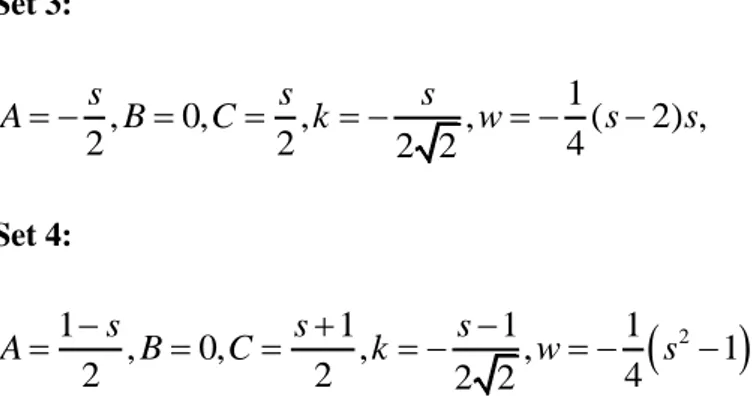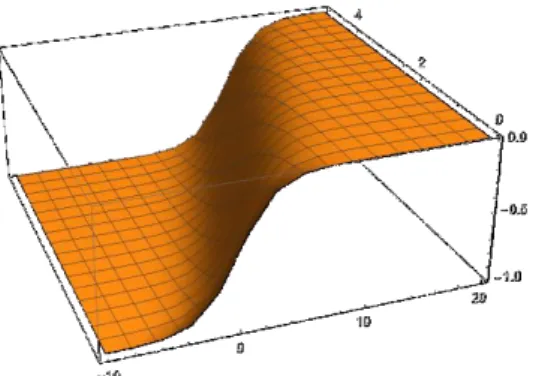The New Travelling Wave Solutions of Time Fractional Fitzhugh-Nagumo
Equation with Sine-Gordon Expansion Method
Orkun TAŞBOZAN1, Ali KURT2,*
1Hatay Mustafa Kemal University, Faculty of Science and Literature, Department of Mathematics, Hatay,
Turkey
otasbozan@mku.edu.tr, ORCID: 0000-0001-5003-6341
2Pamukkale University, Faculty of Science and Literature, Department of Mathematics, Denizli, Turkey
akurt@pau.edu.tr, ORCID: 0000-0002-0617-6037
Received: 19.01.2019 Accepted: 21.03.2020 Published: 25.06.2020
Abstract
Authors aimed to employ the sine-Gordon expansion method to acquire the new exact solutions of fractional Fitzhugh-Nagumo equation which is a stripped type of the Hodgkin-Huxley model that expresses in extensive way activation and deactivation dynamics of neuron spiking. By using the wave transformations, by the practicality of chain rule and applicability of the conformable fractional derivative, the fractional nonlinear partial differential equation (FNPDE) changes to a nonlinear ordinary differential equation. So the exact solution of the considered equation can be obtained correctly with the aid of efficient and reliable analytical techniques.
Keywords: Sine-Gordon expansion method; Fitzhugh-Nagumo Equation; Conformable derivative.
Zaman Kesirli Fitzhugh-Nagumo Denkleminin Sine-Gordon Açılım Yöntemi İle Yeni Yürüyen Dalga Çözümleri
Yazarlar, nöron artışının, geniş bir aktivasyon ve deaktivasyon dinamiğini ifade eden Hodgkin-Huxley modelinin sade bir tipi olan kesirli Fitzhugh-Nagumo denkleminin yeni tam çözümlerini elde etmek için sine-Gordon açılım yöntemini kullanmayı amaçladılar. Dalga dönüşümleri, zincir kuralının pratikliği ve conformable kesirli türevin uygulanabilirliği kullanılarak, lineer olmayan kesirli mertebeden kısmi diferansiyel denklem, lineer olmayan adi diferansiyel denkleme dönüşür. Böylece, ele alınan denklemin tam çözümü etkin ve güvenli analitik tekniklerin yardımı ile doğru bir biçimde elde edilebilir.
Anahtar Kelimeler: Sine-Gordon açılım yöntemi; Fitzhugh-Nagumo denklemi; Conformable türev.
1. Introduction
Fractional calculus that is gone by the name of as arbitrary order differentiation and integration is as old as known calculus. At the beginning fractional derivation was seen as a great paradox in L'Hospital's letter to Liouville who asked firstly about arbitrary order derivation. So the survey of the fractional calculus has been started. In the last decades many scientists dealt with this subject to explain complexity and nonlinearity of the natural events with more accuracy. But they need some tools for modeling these natural phenomenons. So they expressed some definitions as a tool for modeling physical, engineering and social problems mathematically. Especially Grunwald-Letnikov, Riemann-Liouville and Caputo type fractional order derivation and integration definitions are the most popular ones as modeling tools [1-3]. But recently scientists recognized some deficiencies of these definitions. For instance Riemann-Liouville fractional order derivative of a constant is not zero. Both Riemann-Liouville and Caputo derivative definitions do not satisfy the chain rule. Also these definitions do not satisfy the rule for derivative of quotient of two functions and derivative of product of two functions. To annihilate these deficiencies recently Khalil et al. [4] expressed a new definition called "conformable fractional derivative and integral".
Definition 1. Let 𝑓 ∶ [0, ∞) → ℝ be a function. The
thorder "conformable fractional derivative" (CFD) of f is expressed by,
1 0
(
)
( )
( )( )
lim
f t
t
f t
T
f
t
, for all t0,
(0,1) [4].Definition 2. Let f be
-differentiable over some (0, ),a a0 and ( ) 0 lim ( ) t f t subsists then ( ) ( ) 0 (0) lim ( ) t f f t . The "conformable fractional integral" of a function f starting from 0 a is defined as: 1 ( ) ( )( ) t a a f x I f t dx x
,where considered integral is by means of Riemann improper integral, also,
(0,1] [4]. Basic properties of CFD are declared in [4, 5]. The conformable fractional calculus aroused scientist's great interest and huge amount of implementation of this derivative is visible in the literature [6-9]. Korkmaz [10] constructed the solutions of the conformable fractional RLW-Burgers, potential KdV, and CRWP equations by using the modified Kudryashov method. Rosales et al. [11] used the conformable Laplace transform to get the solution of the classical Drude model. Srivastava et al. [12] employed the conformable DTM to evaluate an numerical solution of the SIR epidemic model of childhood disease. Sabiu et al. [13] evaluated analytical solution for the conformable fractional (3+1) dimensional mKdV equation.In this article authors established the traveling wave solutions of time fractional Fitzhugh-Nagumo Equation
2
( )(1 )
t x
D u D uu us u , (1) which arises in nonlinear reaction-diffusion, the transmission of nerve impulses models [14, 15], circuit theory and the area of population genetics [16] as mathematical models. In Eqn. (1)
(0,1)
and D ut means CFD of function u x t( , ). 2. A Brief Description of Implemented MethodThe sine-Gordon expansion method is represented briefly in this section. Regarded method relying on the sine-Gordon equation [17] and complex wave transformation [18].
Regard the sine-Gordon equation [19];
2
( ),
xx tt
considering uu x t( , ) and
is constant. Supposing the transformation ( , ) ( )uu x t U ,
(xct) in the Eqn. (2) led to,2 2 2
sin( ).
(1
)
U
U
c
(3)By regulating the Eqn. (3), it turns into
2 2 2 2 2 sin , 2 (1 ) 2 U U W c
(4)where W is a constant. Choosing W 0,
( )
2
U
, 2 2 2 2(1
)
o
c
and replacing in Eqn.(4), we get,
sin( ),
o
(5) also establishing o1 in Eqn. (5), yieldssin( ).
(6) The solution of (6) can be evaluated by the method of separation of variables, we have,1 2 2
2
sin( )
sin( ( )
)
|
sec
( ),
1
h
e
e
(7) 2 2 1 2 21
cos( )
sin( ( ))
|
tanh( )
1
e
e
(8)regarding
is constant. For obtaining following conformable PDE's solution; ( , t , x , xx , t t ,...),G u D u D u D u D D u (9)
we use the wave transform
kx
w
t
. So the time fractional nonlinear PDE turns into an integer order ODE
1 0 1( )
tanh ( )
s
e
c
( )
tanh(
)
,
n i i i iU
B
h
A
A
(11) then due to Eqn. (7) and Eqn. (8), Eqn. (11) can be reorganized as
1
0 1
( )
cos ( )
sin( )
cos( )
.
n i i i iU
B
A
A
(12) In the Eqn. (10) using the balancing principlen
can be examined. Equating the coefficients ofcos ( )
i
andsin ( )
i
to zero yields a system. Solving obtained system by using software Mathematica the values ofA
i,B
i, k andw
can be derived. At the end substituting all the obtained the results forA
i,B
i,
andc
in Eqn. (11), the solutions can be derived.3. Wave Solutions of Time Fractional Fitzhugh-Nagumo Equation
We employ above expressed method to acquire the traveling wave solutions of fractional Fitzhugh-Nagumo equation (1). Regarding the wave transform and chain rule [5] to the Eqn. (1) led to
2
(
)(1
),
wU
k U
U U
s
U
(13) where the prime defines derivative of function U with respect to . Applying the balancing procedure between the terms U and U3 gives n1. Suppose that the solution of Eqn. (12) is as followssin( ) cos( ) .
U B A C (14) Subrogating Eqn. (14) into Eqn. (13) and equating all the coefficients of
cos ( )
i andsin ( )
i to be zero, we get the following solution setsSet 1: 2 1 1 1 1 1 , 2 1, , , ( 1)( 1), 2 2 2 2 2 s s s A B s s C k w s s (15) Set 2:
Set 3: 1 , 0, , , ( 2) , 2 2 2 2 4 s s s A B C k w s s (17) Set 4:
2
1 1 1 1 , 0, , , 1 . 2 2 2 2 4 s s s A B C k w s (18) Based on these solution sets, we acquire the following solutions respectively,
2 1 2 21
1
(
1)
( , )
(
1) tanh
2
2
2
1
1
(
1)
1
2
1sech
,
2
2
2
2
s
t
s
x
u x t
s
s
t
s
x
s
s
s
2 1 (2 1) 1 ( , ) tanh , 2 2 2 4 2 x s t u x t
3 1 ( 2) ( , ) tanh , 2 4 2 2 2 s st sx s u x t s
2
41
1
1
(
1)
( , )
(1
) tanh
.
2
2
2 2
4
s t
s
s
x
u x t
s
The 3D graphics of the obtained solutions are given as follows
Figure 2: The 3D graphical representation of u x t3( , ) for s 1, 0.9
Figure 3: The 3D graphics of u x t4( , ) for s 1, 0.9 4. Conclusions
In this study authors obtained the new traveling wave solutions of time fractional Fitzhugh-Nagumo equation with the aid of sine-Gordon expansion method. Obtained results show that the method is applicable, accurate and efficient for acquiring the analytical solutions of FPDEs in conformable sense. Also 3D graphical representations are given for the obtained results. Although authors used the advantages of CFD. In other fractional derivative definitions, the considered equations can’t be turned into ODE with integer order by using wave transform. Also all the solutions are verified by putting them into the considered equation.
References
[1] Miller, K.S., Ross, B., An Introduction to the Fractional Calculus and Fractional Differential Equations, John Wiley &Sons, New York, 1993.
[2] Kilbas, A., Srivastava, H.M., Trujillo, J.J., Theory and Applications of Fractional Differential Equations, Elsevier, San Diego, 2006.
[3] Podlubny, I., Fractional Differential Equations, Academic Press,San Diego, 1999. [4] Khalil, R., Al Horani, M., Yousef, A., Sababheh, M., A new definition of fractional derivative, Journal of Computational and Applied Mathematics, 264, 65-70, 2014.
[6] Çenesiz, Y., Kurt, A., Taşbozan, O., On the New Solutions of the Conformable Time Fractional Generalized Hirota-Satsuma Coupled KdV System, Annals of West University of Timisoara-Mathematics and Computer Science, 55(1), 37-50, 2017.
[7] Taşbozan, O., Şenol, M., Kurt, A., Özkan, O., New solutions of fractional Drinfeld-Sokolov-Wilson system in shallow water waves, Ocean Engineering, 161, 62-68, 2018.
[8] Taşbozan, O., Çenesiz, Y., Kurt, A., Baleanu, D., New analytical solutions for conformable fractional PDEs arising in mathematical physics by exp-function method, Open Physics, 15(1), 647-651, 2017.
[9] Kurt, A., Taşbozan, O., Baleanu, D., New solutions for conformable fractional Nizhnik-Novikov-Veselov system via G′/G expansion method and homotopy analysis methods, Optical and Quantum Electronics, 49(10), 333, 2017.
[10] Korkmaz, A., Explicit exact solutions to some one-dimensional conformable time fractional equations, Waves in Random and Complex Media, 29(1), 124-137, 2019.
[11] Rosales, J.J., Godnez, F.A., Banda, V., Valencia, G.H., Analysis of the Drude model in view of the conformable derivative, Optik, 178, 1010-1015, 2019.
[12] Srivastava, H.M., Gunerhan, H., Analytical and approximate solutions of fractional-order susceptible-infected-recovered epidemic model of childhood disease, Mathematical Methods in the Applied Sciences, 42(3), 935-941, 2019.
[13] Sabiu, J., Jibril, A., Gadu, A.M., New exact solution for the (3 +1)conformable space time fractional modified Kortewegde-Vries equations via Sine-Cosine Method, Journal of Taibah University for Science, 13(1), 91-95, 2019.
[14] Fitzhugh, R., Impulse and physiological states in models of nerve membrane, Biophys. J., 1, 445-466, 1961.
[15] Nagumo, J.S., Arimoto, S., Yoshizawa, S., An active pulse transmission line simulating nerve axon, Proc. IRE, 50, 2061-2070, 1962.
[16] Aronson, D.G., Weinberger, H.F., Multidimensional nonlinear diffusion arising in population genetics, Adv. Math., 30, 33-76, 1978.
[17] Yan, C., A simple transformation for nonlinear waves, Physics Letters A, 224(1), 77, 1996.
[18] Çenesiz, Y., Kurt, A., New fractional complex transform for conformable fractional partial differential equations, Journal of Applied Mathematics, Statistics and Informatics, 12, 2, 2016.
[19] Rubinstein, J., Sine-Gordon Equation, Journal of Mathematical Physics, 11(1), 258-266, 1970.

